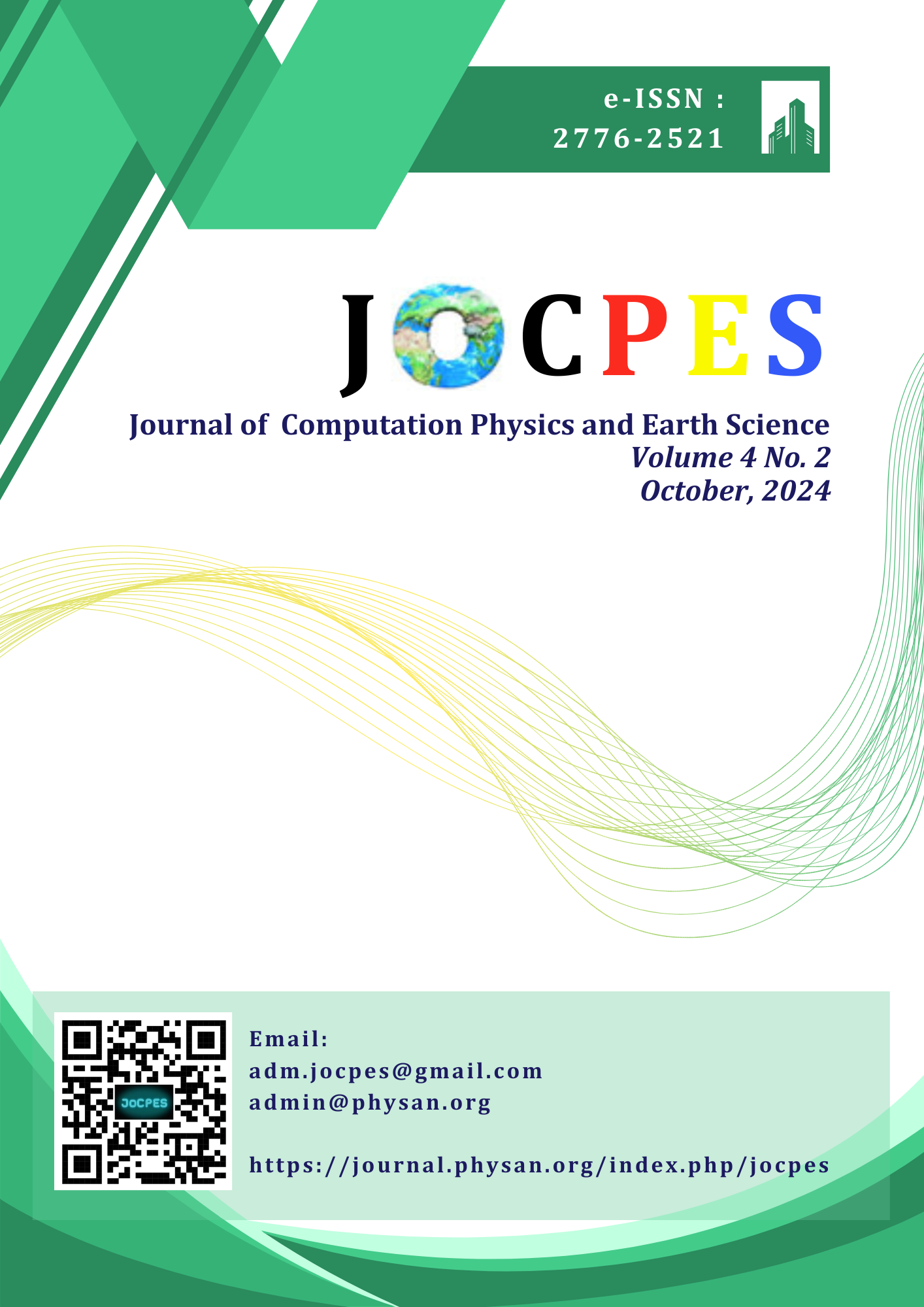Application of Himawari-9 and Radiosonde Data in Analyzing Extreme Rainfall Events (Case Study: Malang, November 25, 2023)
Main Article Content
Abstract
This study uses Himawari-9 meteorological satellite data and radiosonde data to examine the severe rain event that happened in Malang on November 25, 2023. The Japan Meteorological Agency's (JMA) Himawari-9 satellite collects high-frequency atmospheric data, and radiosonde data provide vertical atmospheric information. This study determines the distribution of major convective clouds and meteorological characteristics that suggest the possibility of severe weather by analyzing satellite photos using the RGB technique and radiosonde data. Convective clouds identified by satellite images at 07:40 UTC started to blanket the Malang City area and spread until they filled the entire East Java region at 09:00 UTC, according to the analysis's findings. Weather metrics including the Showalter Index (SI), Lifted Index (LI), and Convective Available Potential Energy (CAPE) are displayed in radiosonde data to support the possibility of heavy rain. There is a significant chance that flooding in Malang will result from heavy rains due to these unstable atmospheric conditions.
Downloads
References
W. Estiningtyas, H. Syahbuddin, Harmanto, A. Pramudia, and S. K. Dermoredjo, “Analysis of key locations as indicators for extreme climate impacts in supporting climate change adaptation in Indonesia,” IOP Conf. Ser. Earth Environ. Sci., vol. 724, no. 1, 2021, doi: 10.1088/1755-1315/724/1/012042.
H. Setiyono, A. N. B. Bambang, M. Helmi, and M. Yusuf, “Effect rainfall season on coastal flood in Semarang City, Central Java, Indonesia,” Int. J. Health Sci. (Qassim)., vol. 6, no. March, pp. 7584–7595, 2022, doi: 10.53730/ijhs.v6ns1.6618.
J. I. Hamada, M. D. Yamanaka, S. Mori, Y. I. Tauhid, and T. Sribimawati, “Differences of rainfall characteristics between coastal and interior areas of Central Western Sumatera, Indonesia,” J. Meteorol. Soc. Japan, vol. 86, no. 5, pp. 593–611, 2008, doi: 10.2151/jmsj.86.593.
A. Safril, H. Saputra, S. Siswanto, A. N. Khoir, and A. K. Al Arif, “The Effect of Non-Seasonal Climate Variations on Extreme Rainfall Events in Early Rainy Season Onset in Southest West Java Province,” J. Penelit. Fis. dan Apl., vol. 10, no. 2, p. 173, 2020, doi: 10.26740/jpfa.v10n2.p173-187.
I. Narulita and W. Ningrum, “Extreme flood event analysis in Indonesia based on rainfall intensity and recharge capacity,” IOP Conf. Ser. Earth Environ. Sci., vol. 118, no. 1, 2018, doi: 10.1088/1755-1315/118/1/012045.
T. Walczykiewicz and M. Skonieczna, “Rainfall flooding in urban areas in the context of geomorphological aspects,” Geosci., vol. 10, no. 11, pp. 1–18, 2020, doi: 10.3390/geosciences10110457.
M. Rizqy Nugraha et al., "Radiosonde System Using ESP32 and LoRa Ra-02 Web-Based for Upper-Air Profile Observation," 2024 International Conference on Information Technology and Computing (ICITCOM), Yogyakarta, Indonesia, 2024, pp. 213-217, doi: 10.1109/ICITCOM62788.2024.10762300.
K. Bessho et al., “An introduction to Himawari-8/9 — Japan’s new-generation geostationary meteorological satellites,” J. Meteorol. Soc. Japan, vol. 94, no. 2, pp. 151–183, 2016, doi: 10.2151/jmsj.2016-009.
J. Liu et al., “Near-real-time atmospheric and oceanic science products of Himawari-8 and Himawari-9 geostationary satellites over the South China Sea,” Earth Syst. Sci. Data, vol. 16, no. 10, pp. 4949–4969, 2024, doi: 10.5194/essd-16-4949-2024.
H. Hirose, S. Shige, M. K. Yamamoto, and A. Higuchi, “High temporal rainfall estimations from himawari-8 multiband observations using the random-forest machine-learning method,” J. Meteorol. Soc. Japan, vol. 97, no. 3, pp. 689–710, 2019, doi: 10.2151/jmsj.2019-040.
X. Chen et al., “Rainfall Area Identification Algorithm Based on Himawari-8 Satellite Data and Analysis of its Spatiotemporal Characteristics,” Remote Sens., vol. 16, no. 5, pp. 1–20, 2024, doi: 10.3390/rs16050747.
Risyanto, F. Lasmono, and G. A. Nugroho, “Identification of rainfall area in Indonesia using infrared channels of Himawari-8 Advance Himawari Imager (AHI),” IOP Conf. Ser. Earth Environ. Sci., vol. 303, no. 1, 2019, doi: 10.1088/1755-1315/303/1/012057.
K. Fuell, B. Guyer, D. Kann, A. Molthan, and N. Elmer, “Next generation satellite RGB dust imagery leads to operational changes at NWS Albuquerque,” J. Oper. Meteorol., vol. 04, no. 06, pp. 75–91, 2016, doi: 10.15191/nwajom.2016.0406.
K. Fuell, B. Guyer, D. Kann, A. Molthan, and N. Elmer, “Next generation satellite RGB dust imagery leads to operational changes at NWS Albuquerque,” J. Oper. Meteorol., vol. 04, no. 06, pp. 75–91, 2016, doi: 10.15191/nwajom.2016.0406.
M. A. Broomhall, L. J. Majewski, V. O. Villani, I. F. Grant, and S. D. Miller, “Correcting Himawari-8 advanced Himawari imager data for the production of Vivid True-Color imagery,” J. Atmos. Ocean. Technol., vol. 36, no. 3, pp. 427–442, 2019, doi: 10.1175/JTECH-D-18-0060.1.
M. Putra, M. S. Rosid, and D. Handoko, “High-Resolution Rainfall Estimation Using Ensemble Learning Techniques and Multisensor Data Integration,” Sensors, vol. 24, no. 15, 2024, doi: 10.3390/s24155030.
One Data Malang, “Portal One Data Malang,” https://onedata.malangcity.go.id/ (accessed: Jul. 21, 2024).
One Data Malang, “Portal One Data Malang,” https://onedata.malangcity.go.id/ (accessed: Jul. 21, 2024).
A. Kurniadi, E. Weller, S. K. Min, and M. G. Seong, “Independent ENSO and IOD impacts on rainfall extremes over Indonesia,” Int. J. Climatol., vol. 41, no. 6, pp. 3640–3656, 2021, doi: 10.1002/joc.7040.
A. P. Ferreira, R. Nieto, and L. Gimeno, “Completeness of radiosonde humidity observations based on the Integrated Global Radiosonde Archive,” Earth Syst. Sci. Data, vol. 11, no. 2, pp. 603–627, 2019, doi: 10.5194/essd-11-603-2019.
R. D. Yudistira et al., “Utilization of surface meteorological data, Himawari-8 satellite data, and radar data to analyze landspout in Sumenep, East Java, Indonesia (case study of 20 November 2017),” IOP Conf. Ser. Earth Environ. Sci., vol. 374, no. 1, 2019, doi: 10.1088/1755-1315/374/1/012038.
C. P. da Silva Neto, H. Alves Barbosa, and C. A. Assis Beneti, “A method for convective storm detection using satellite data,” Atmosfera, vol. 29, no. 4, pp. 343–358, 2016, doi: 10.20937/ATM.2016.29.04.05.
T. H. M. Stein et al., “The Dymecs project: A Statistical approach for the evaluation of convective storms in high-resolution NWP models,” Bull. Am. Meteorol. Soc., vol. 96, no. 6, pp. 939–951, 2015, doi: 10.1175/BAMS-D-13-00279.1.
A. Lorente et al., “Structural uncertainty in air mass factor calculation for NO2 and HCHO satellite retrievals,” Atmos. Meas. Tech., vol. 10, no. 3, pp. 759–782, 2017, doi: 10.5194/amt-10-759-2017.

